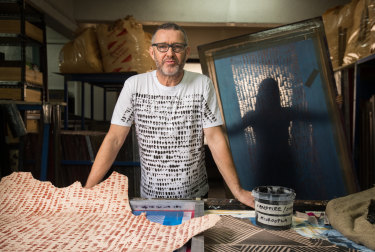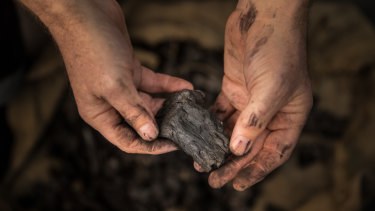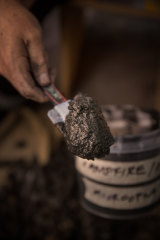
From campfire to pigment: a journey of artistic endeavour
07/05/2019Around a campfire beside the Goulburn River near Shepparton, a group of creative people have gathered. They have many ideas for artworks and are thinking about interesting new ways of making them. Moreover, they want to chat, be together, tell stories.
When the fire fades, they gather its remnant charcoal. Watching is Stewart Russell, a Scottish-born artist, who seems to thrive on working with others to realise their own projects. While he has his own strong creative life, he is energised by sharing production processes to help other artists get where they want to go. He sees the campfire as a curatorial concept, a fruitful gathering of interested parties, and one he wants to continue.
Stewart Russell in the Spacecraft Studio. Credit:Simon Schluter
Soon after arriving in Australia in 2000, Russell was drawn to working with Indigenous artists, fired up by the integrity and beauty of their work. By 2001, he was working with Tiwi Islands' artists. Now, with his Spacecraft Studio business well-established, and many other projects and collaborations later, the fruits of success scatter far and wide.
The charcoal from the campfire has had an interesting journey since it was created on that night earlier this year when artists from the Shepparton Indigenous group, Kaiela Arts, gathered. Attendees included Kaiela manager Angie Russi, local elder and artist Cynthia Hardie, videographer Cecilia Hedditch, Russell and his Spacecraft Studio colleague Clara Gladstone.
More people dropped in. The artists tested out thoughts they had for print-based works. They talked about trees and how they have stood there for so long, witnessing history. They discussed how some of the artists’ families had come to Shepparton and Mooroopna. Hardie, as an elder, spoke about the 1930s Depression and how Indigenous people gravitated to camps along the river, set out beside Yugoslavian and Italian migrants looking for fruit-picking work.
All this led to talk of using charcoal pigment made from the fire to tell stories in prints, and how various technologies might be used to incorporate it.
‘‘We used the campfire to get to know one another better,’’ Russell says. ‘‘The artists told their own stories and we told ours: exploits on the football fields, cultural mentors they wanted to acknowledge, how technical skills are acquired, families …’’
Russell, who initiated the gathering along with Kaiela Arts, says the event was a curatorial brainwave. Spacecraft Studio, in Collingwood, has been working with Kaiela Arts for three years, but with Indigenous artists from the Shepparton area for at least eight years, initially through commissions via the Koorie Heritage Trust. In this case, the campfire format is a solution to working with a changing group of artists with a wide range of experiences.
‘‘Rather than them coming to us, we go up there and sit around the campfire and test their ideas against other people in that situation,’’ Russell says. “The other reason for framing it around this idea of the campfire was to make the pigment.’’
Charcoal from a campfire was used to create ink. Credit:Simon Schluter
Russell and Gladstone (a technical master) took the blackened chunks of burnt wood back to Spacecraft and reduced each grain to as tiny as three microns (a micron is a millionth of a metre, so very tiny particles). Then, this pigment was combined with a carrier emulsion and turned into ink.
Blackened chunks of burnt wood were reduced to tiny grains and combined with a carrier emulsion to become ink.Credit:Simon Schluter
The campfire artists got to work on designs and, using the ink, they have produced bags, cushions, T-shirts and other objects to sell at the National Gallery of Victoria in time for NAIDOC week, with a chunk of funds flowing back to creators.
Russell loves making these things happen and is a committed collaborator: his achievements are quietly powerful and based on conversations rather than directives. He’s not a big-noter, so it takes a while to discover how far his many creative endeavours reach.
He also collaborates with artists such as Brook Andrew, Yhonnie Scarce, Lisa Waup, Bindi Cole Chocka and Reko Rennie and works with organisations including the Victorian College of the Arts, the National Gallery of Victoria and Sydney Biennale. Many of his commissions via Spacecraft have been for architectural projects in Australia and Japan. For his own artwork, Russell often joins forces with artist Kate Daw.
Russell says he takes his own experiences and thoughts on cultural identity and the role of an artist – all informed by growing up in Scotland – into his working relationships with artists, who also have a diverse range of cultural perspectives.
‘‘I guess all collaboration requires listening and asking questions to understand each other, but invariably I find more that connects than divides,’’ he writes in an email after our interview. While he says his role can take many guises, he hasn’t noticed any more complications or sensitivities working with Indigenous artists.
They are all adventures, and Russell enjoys describing how his collaborations manifest. Two particular projects in recent years stand out. One was with Brook Andrew, who unearthed ‘‘ethnographic’’ photos of unidentified Aboriginal people and sought out Russell about making an artwork that showed these people ‘‘there, but not there; to appear and disappear’’. He also wanted them to be big, to have a homecoming.
Using a lot of grey mid-tones on a metallic surface, when they first printed the large images and hung them on the wall at Spacecraft, ‘‘you couldn’t see it’’, Russell says. ‘‘It was flat, grey, nothing.’’
But viewed from the side, the figure in the image shimmered into sight. It was perfect. The 2007 Gun-metal Grey works do exactly what Andrew wanted: appear and disappear. Since then, Andrew and Russell have often collaborated.
More recently, in 2016, Russell and Kate Daw commissioned Yorta Yorta opera singer Deborah Cheetham to help them create an artwork exploring ‘‘the impossibility of the claims of national symbols’’. While Russell and Daw made a series of large screenprints, intertwining the story of AFL player Liam Jurrah and the symbolism of the Melbourne Cricket Ground, Cheetham created an ‘‘upside down and back-to-front’’ version of our national anthem, then taught it to some young opera singers. ‘‘Listening to it, it is not at all like playing the original backwards,’’ Russell says. ‘‘It is a completely different thing. It is very plaintive, a beautiful lament.’’
As for the very recent campfire charcoal printing experiments, the objects – some on kangaroo hide – are also rich with feeling, thanks to artists Suzanne Atkinson, Tammy Lee Atkinson, Eric Brown and Eva Ponting. And there among these works of art, displayed on a table at Spacecraft, Russell has kept a hessian cloth filled with lumps of charcoal: a reminder of the beautiful transformations and connections art-making can deliver.
NAIDOC Week runs July 7-14. naidoc.org.au
Source: Read Full Article




